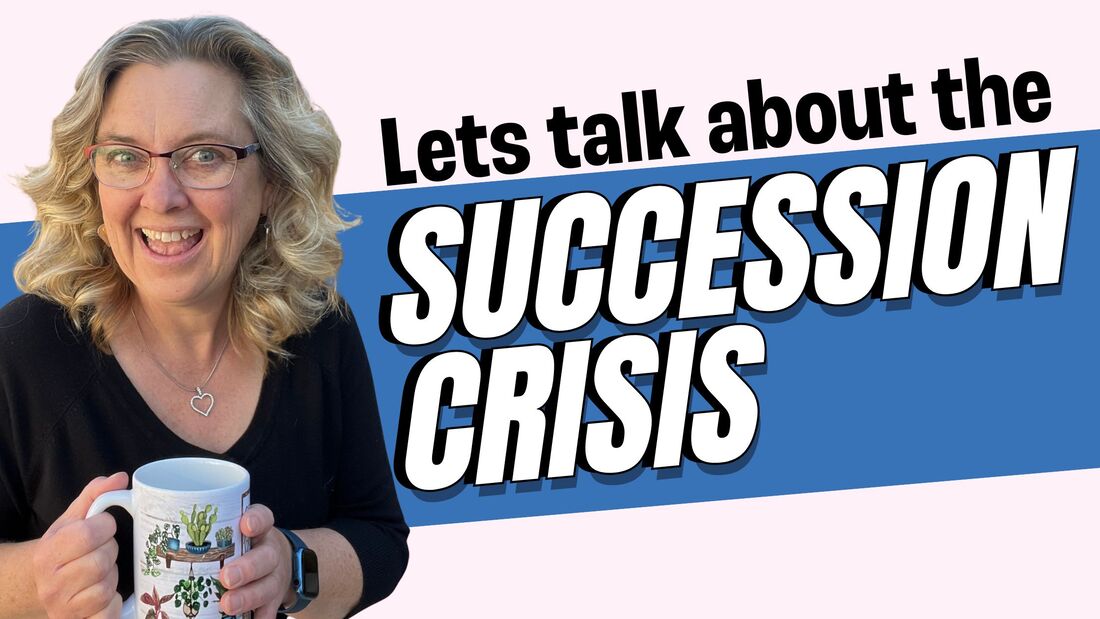
“Who’s going to lead this place when I’m gone?”
I’ve heard this thought more and more over the last few years in my coaching conversations. I’ve noticed that many leaders are afraid to speak about it in their organization. And that fear of speaking about it is causing challenges in organizations.
We need to talk about succession planning, not as a formal HR process or a massive document but as a necessary leadership conversation. A conversation that builds hope creates sustainability and helps our sector thrive.
In a recent episode of CharityVillage Connects, I had the opportunity to speak with Mary Barroll from CharityVillage about the very real succession crisis facing nonprofit organizations.
I’m grateful for the conversation because we need to have conversations more often and more openly.
Here’s some of what Mary and I discussed and a bit more to help you, whether you’re the current leader thinking of stepping away or someone wondering what the future holds for your organization.
We’re in a Succession Crisis and It’s Not Going Away
- Boards aren’t initiating the conversation.
- Leaders feel unsure of how to bring it up.
- Staff are left in the dark.
The result? A lack of true leadership on the team and in the organization, lost momentum, and talented individuals walked away from roles they might have otherwise stepped into if the path had been clearer and they had felt supported to grow and step into the role.
Succession planning isn’t just about choosing a replacement. It’s about growing the next leader, helping them build their confidence and capacity. At the same time building confidence in that upcoming leader across the organization. Without it, we risk confusion, instability, and a big mess when something initiates the leader moving on.
- Avoidance from the board – Many boards don’t want to “poke the bear,” especially if the current leader is also the founder. They aren’t sure they can legally ask those questions. Or they wonder if it will give the wrong message to the leader that they aren’t wanted anymore.
- Survival mode culture – When we’re all trying to keep up with reporting deadlines, funder demands, and program pressures, planning for something five years down the road feels impossible.
And yet, that’s exactly why we need to start now.
We’ve Made Leadership Look Unappealing
Many emerging leaders look at their Executive Directors and see burnout, endless meetings, emotional labour, and a to-do list that never ends. And think, I don’t want that life.
We’ve created a culture of doing-too-much, and we’ve called it leadership.
If we want to attract and retain future leaders, we need to start modelling leadership in a healthier, more sustainable way.
We’re Not Preparing People for What Leadership Really Takes
When someone is promoted from the front line into a leadership role, they’re often handed policies, reporting forms, and a few HR documents—and expected to figure the rest out.
But technical tasks are only part of the job.
What new leaders really need to learn are:
- How to motivate and inspire others
- How to manage your emotions (and your team’s)
- How to build hope during change and uncertainty
- How to have tough conversations and deal with prickly personalities
- How do you set boundaries when you are a people pleaser, perfectionist, or performer so you don’t burn out?
We call them “soft skills,” but they’re foundational to effective leadership. And in most nonprofits, they’re rarely taught.
That lack of preparation leaves new leaders overwhelmed and uncertain, and it reinforces the cycle of burnout and leadership avoidance.
If You’re the Leader Who’s Afraid to Say You’re Leaving…
Start small. You don’t need a specific date. You can begin by saying, “I’ve been thinking about the long-term sustainability of this organization.” That opens the door to deeper conversations.
Begin identifying people with leadership potential even if they’re not ready yet. Invite them to shadow you, take the lead on projects, or join strategic conversations. Share the human side of leadership with them. Talk about your values and how you reflect and make decisions. It’s the why behind why we do our work, not just the calendar full of meetings.
And be honest about what’s hard. But also share what’s meaningful. When we talk about leadership as a calling, not just a job, we reframe it as something to grow into. Not something to avoid.
If You’re Not the Leader—but You’re Wondering What’s Next…
With a bit of courage, you can start a respectful conversation about their plans.
- “How are you feeling about the future of your role?”
- “What kind of support would help us plan for long-term success?”
You don’t need to demand a retirement date. But you can open a conversation about what they are considering for themselves and how they see things for future employees and the team.
If you have leadership potential or a desire to be in leadership, don’t wait for someone to suggest that you consider leadership. Begin your own growth journey. Read, reflect, take online courses, join communities, and find mentors.
Making Leadership Development Part of Everyday Culture
Here are some suggestions:
- Make your 1:1s count – Don’t just talk about program tasks. Ask, “What skills, both practical or soft skills, do you want to develop this year?” or “Where do you think you have the most opportunity to grow this year?”
- Encourage mentorship – Be clear that you aren’t the only one from whom they can learn leadership. Encourage them to look around for other people to learn leadership from and be open to connecting them to others.
- Start a book club – Choose a leadership book and meet weekly to discuss it. (Character Driven Leadership for Women would work great for this!) This allows you to both learn and be open to discussing your leadership journeys.
- Promote emotional intelligence – Talk about composure, reflection, and mindset just as much as strategy and deadlines.
When development becomes part of your culture, succession planning stops being a looming project. It becomes the natural result of how you work together.
Start reading Character Driven Leadership for Women – A 5-Step Guide to Shape Your Nonprofit Management Style with Strong Values, Ethics and Morals today and discover how to lead your team in a way that feels aligned with your values, impactful and maybe even enjoyable!
What Boards Need to Do (And Often Avoid)
However, from a governance perspective, succession planning is, in part, the board’s responsibility.
Start with simple questions:
- “What’s your vision for the next 3–5 years?”
- “Who’s on your radar in terms of leadership potential?”
- “How can we support you in preparing for the future?”
If you’re unsure how to help, get training on succession planning. There are tons of resources for boards better to understand governance, transition planning, and leadership support. It’s okay not to know.
Whether you’re the one considering your exit or the one wondering who’s next, succession planning starts with inner work.
It starts with self-reflection:
- What are your values?
- What kind of leader do you want to be (or support)?
- How can you show up with courage and compassion, even when the conversation is hard?
No matter where you sit in your organization, you have the power to spark these conversations.
You don’t need a perfect plan today. But you do need to begin. Listen to my full interview with Mary Barroll here.
And if you’re looking for support as you navigate this journey, The Training Library is here for you. It’s where nonprofit leaders come to build confidence, gain clarity, and grow into the leaders their organizations need, now and in the future.
~ Kathy
Do the inner work. It’s worth it!
P.S. Head in the sand isn’t leadership! Leading the V formation is!
Spring is here! I hear the geese flying overhead!
I’ve been where you are, juggling leadership demands while trying to find balance and confidence. I created The Training Library to provide nonprofit leaders like you with practical, on-demand courses and personalized coaching, all within reach.
It’s like having a trusted mentor in your corner, guiding you through every challenge.
No more second-guessing. No more struggling alone.
Inside The Training Library, you’ll gain the skills and confidence to lead with ease, balance, and impact—so you can thrive at work and in life.
Master Nonprofit Leadership—With Training, You Can Trust.
Join The Training Library today and take the first step toward confident leadership.


